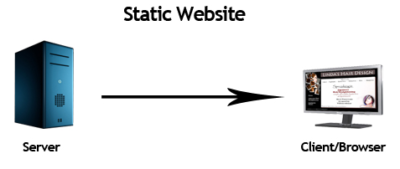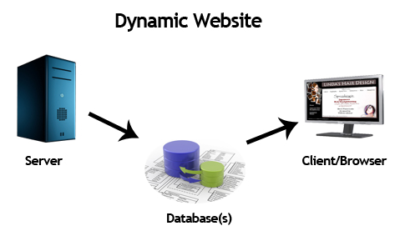The number of websites on the internet is currently estimated to be over 2 billion. Businesses frequently communicate with customers through their
The number of websites on the internet is currently estimated to be over 2 billion.
Businesses frequently communicate with customers through their websites, and customers know what to expect from these platforms. Visitors generate opinions about your website in less than a second, which is why it’s critical to create a website that leaves a fantastic first impression.
What is a Static Website?
The fact that every user gets and sees the same content is one of the things that makes a site static. Static websites work best for sites with fewer pages that don’t need to be changed or updated often.

A website for a resume is a good choice for a static site. This is a type of website where each page has the same content and doesn’t need many changes or real-time updates based on how people use it. Personal websites, websites for non-profits, and websites that only give information are also common static website types (good examples of these include one-page or landing page sites).
Advantages of a static website
- Faster time for a page to load
Static pages are made so that they load quickly, which makes it easier to browse. Because the content on this kind of site is already written and comes straight from the server, caching is easier, and the content is less likely to take too long to load or have problems with the user experience, like broken images.
In general, static websites use less server power and are faster because they don’t have to go through a database or client-server infrastructure. Since page load speed is a key part of how Google measures a website’s performance (and it seems to be having a bigger effect on SEO and ranking performance, too), this ability should not be undervalued.
- Less efficient management
Static websites might be easier to make, but they can take more time to run. Edits to a static website have to be made one page at a time. As a website gets more content or content that changes quickly, this task becomes much harder, and in some cases, almost impossible.
Things that affect the cost of static website design in India
You might be thinking about making a new website for your business or yourself. And you want to know how much a website costs in India or how much to charge for a static website. If you are a freelance developer, this information will also help you.
- The price of a 5-page static website in India
If you want a cheap website that won’t break the bank, you can start with 5 pages. This is a small site for personal or small business use. Home, About Us, Products or Services, Enquiry, and Contact Us are the pages on this website.
- You can choose any other five-page document.
This website will cost between INR 5,000 and 8,000, which includes the domain name and hosting.
- The price of a single-page static website in India
The cheapest kind of website is one that only has one page. It only has one page, but all the information is on that one page. Everything you need to know about the business, its products, and its services is on the home page.
This one-page website starts at 3500/-, which includes the domain name and hosting. FODUU provides an affordable user-friendly website starting from 2999/-. You can ask FODUU for an affordable Static Website Quotation to meet your requirements.
The cost of this one-page website in India will depend on the website development company and developer.
- Everything on one page
Based on this factor, the cost of a website will go up the more work or content goes into making a single page.
So, how much does a site that doesn’t change cost in India?
In India, the starting price for a simple, static website is between Rs. 3,000 and Rs. 5,000, and it can go up to Rs. 1,000,000. Basically, you can say that the cost of your website will go up the more content you want to put on it.
What is a Dynamic Website?
Dynamic websites are built with server-side language and technology, which means that the content of each page can be delivered and shown on the fly, based on how users interact with the site or on user-generated content.

With a dynamic website, all of your data and content are stored in a database or backend Content Management System (CMS), which is linked to your website pages. How and when this information shows up on a page depends on how it is set up and how it is linked to your site’s design.
So, what does it all mean? Well, dynamic content lets you customize and personalize the way a website works and what it shows for each user. It also lets you make changes to many pages at once, since changes to one dynamic page can be made automatically to thousands more.
Dynamic websites, for instance, let you choose which information to show a user based on where they are.
You can also give users content based on what they are doing or have done on your site (thanks to cookies). This means that each visitor sees a different version of the page’s content. A website with more than one language is a great example of when it might be useful to make a dynamic website.
Instagram, Disney, and other well-known sites are also examples of dynamic websites.
FODUU offers affordable dynamic website packages starting at 4499 rupees.
What Advantages of Dynamic Websites?
- Easy to make an update
To start a business and build a brand online, you need content that is always up to date. You need to keep up with changes, updates, and trends in your business and in your industry as a whole. The best way to do this is with a website that changes over time.
With a dynamic website, if the content on one-page changes, it can be copied automatically to other pages without having to change the way the site looks. This is important for sites with a lot of pages because it makes it easier to keep a website up to date.
- A better experience for the user
A dynamic website changes its content based on what the user wants. This could mean showing them information on the page based on where they are or changing the content to match their interests, goals, or what they’ve done on the page before.
No matter what, visitors will have a better time if they can change what they see and how they interact with it.
This ability to customize also makes it more likely that they’ll come back to your site or do something else on it, which can lead to more conversions.
Static vs Dynamic Website
Static web design and dynamic web design are two different approaches to creating a website.
Static web design refers to websites that have fixed content and do not change over time. These websites are created using HTML and CSS, and their content is determined at the time of design and cannot be modified without changing the code.
Static websites are typically simpler and faster to create, and they are suitable for businesses that do not require frequent updates to their website content.
On the other hand, dynamic web design refers to websites that have content that can be modified and updated easily, without requiring changes to the underlying code.
Dynamic websites are typically more complex and require more time and resources to develop, but they offer the advantage of being able to easily update and change the content on the website. Dynamic websites are suitable for businesses that need to frequently update their content, such as e-commerce websites or news websites.
When deciding which type of web design to use for your business, you should consider your specific needs and goals. If you only need a simple website that does not require frequent updates, a static web design may be the most appropriate choice.
If you need a more complex website that allows you to easily update and change the content, a dynamic web design may be the better option.
What to choose: a static or dynamic website?
- Budget: Dynamic web design typically requires more time and resources to develop, so it may be more expensive than static web design. If budget is a concern, a static web design may be the more cost-effective option.
- Complexity: As mentioned earlier, dynamic web design is generally more complex than static web design. If you have limited technical skills or resources, a static web design may be simpler to manage.
- Maintenance: Dynamic websites require ongoing maintenance to ensure that they are running smoothly and that the content is up-to-date. If you do not have the time or resources to devote to ongoing maintenance, a static web design may be a better fit for your business.
- Functionality: If you need a website with advanced functionality, such as the ability to process online transactions or collect user data, a dynamic web design may be the more appropriate choice.
- SEO: Search engine optimization (SEO) refers to the practice of optimizing a website to improve its ranking in search engine results. Static websites can be optimized for SEO, but dynamic websites generally offer more flexibility and control in terms of SEO. This is because dynamic websites allow you to easily update and modify the content on your website, which can help to improve your search engine rankings.
- Scalability: If you expect your business to grow or change over time, you may want to consider a dynamic web design. Dynamic websites are generally more scalable and can be easily modified to meet the changing needs of your business. On the other hand, static websites may require more work to update or modify as your business grows and evolves.
- User experience: A dynamic web design can provide a more interactive and engaging user experience for visitors to your website. For example, a dynamic website may allow users to leave comments, submit forms, or interact with the content in other ways. This can make your website more engaging and increase the likelihood of repeat visits from users.
Conclusion
Ultimately, the best choice for your business will depend on your specific needs and goals. It may be helpful to consult with a web design professional or agency to determine the best approach for your business.
FODUU provides static and dynamic websites at affordable prices. Along with static and dynamic websites, we at FODUU also offer eCommerce websites with unique and trendy features and designs created by our experienced website designers and developers. Contact us now.

